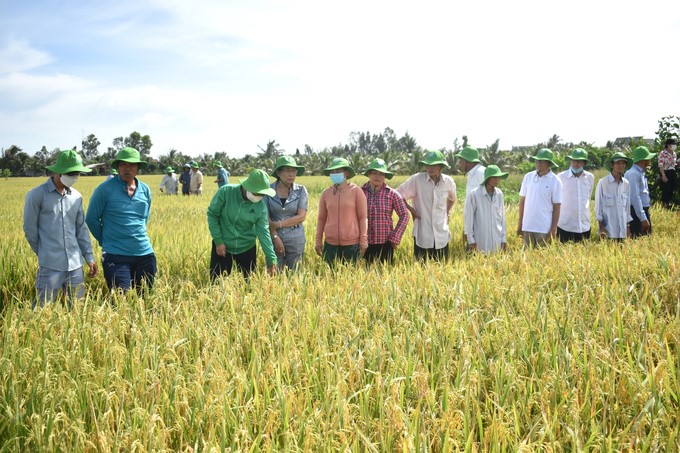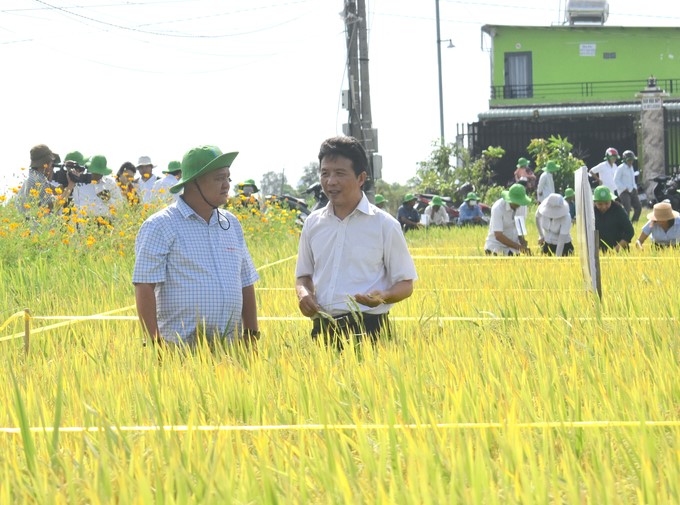May 31, 2025 | 02:25 GMT +7
May 31, 2025 | 02:25 GMT +7
Hotline: 0913.378.918
May 31, 2025 | 02:25 GMT +7
Hotline: 0913.378.918
In Tan Trung commune (Go Cong city, Tien Giang province), previously, farmers tended to sow thickly, overfertilize with nitrogen fertilizer, and spray a lot of pesticides. Under the direction of the Plant Protection Department, the Southern Regional Plant Protection Center has implemented an integrated plant health management (IPHM) model on rice plants to change farmers' awareness of protecting the field ecosystem.

Farmers visit the rice production model applying IPHM in the summer-autumn crop of 2024 in Tan Trung commune, Go Cong city, Tien Giang province. Photo: Minh Dam.
In the IPHM model, farmers reduce the amount of seeds and fertilize with the N-P-K formula (90-60-30) combined with basal fertilization of 200 kg/ha of organic fertilizer. Outside the model, farmers sow with a seed amount of up to 160 kg/ha, fertilize with the N-P-K formula (120-40-30), and do not use organic fertilizers.
Compared to fields outside the model, fields applying IPHM have low pest density. Many natural enemies appear in the field. Although pests and diseases appear, they are at a mild level and do not need to be treated with pesticides. At the end of the crop, the yield reaches 6.85 tons/ha, while the yield outside the model reaches 6.71 tons/ha.
The above-mentioned results of the IPHM model are thanks to reducing seed by 40 kg/ha, reducing nitrogen fertilizer by 30 kg/ha, and increasing organic fertilizers, so rice plants are healthy and resistant to pests and diseases, especially rice leaf folder, blast disease, and bacterial leaf blight disease, thereby reducing pesticide spraying times and costs.
Regarding economic efficiency, compared to fields outside the model, fields with IPHM application have an investment cost of nearly USD 656/ha (decreasing by more than USD 74/ha); a total revenue of nearly USD 1,967/ha (increasing by slightly over USD 40/ha); and profits of nearly USD 1,311/ha (increasing by over USD 114/ha).

Experts, scientists, and farmers exchange and share about the results of model implementation. Photo: Minh Dam.
In addition, the model arranged three experiments on reducing sowing density, reducing nitrogen content, increasing organic fertilizer application, and cutting rice leaves to simulate rice leaf folder causing damage in the field. As a result, demonstration experiments have reduced the amount of seed, nitrogen fertilizer, pesticide spraying times, and production costs; increased profits; and protected the ecological environment while still ensuring productivity.
Mr. Bui Van Xem, a farmer in Tan Trung commune with 1.1 hectares of rice, said that applying IPHM has helped reduce the amount of seed, fertilizer, and pesticide spraying times compared to before. Thereby, he saved over VND 2 million in investment costs.
"When using fertilizer according to the process in the model, rice plants have strong roots, are free from pests and diseases, and reduce pesticide spraying times. At first, we did not trust basal fertilization very much, but when we tested it, we found it very effective. This land is alum and salty. Thanks to phosphorus fertilization, rice plants do not suffer from alum poisoning; the rice root system grows very strong; rice grows well and is not attacked by rice thrips," said Mr. Xem.
Mr. Tran Minh Hoang, Director of Go Cong City Agricultural Service Center, shared: "The integrated plant health management model is upgraded from the integrated pest management (IPM) program combined with technical advances such as '1 must, 5 reductions' and '3 reductions, 3 increases'. This model helps farmers save a lot of production costs, increases rice production efficiency, is very suitable for the city's production conditions, and is suitable for replication."

Mr. Nguyen Minh Thu (right) and Mr. Chau Minh Hai shared about the rice farming model applying IPHM in Go Cong. Photo: Minh Dam.
As a companion enterprise in the model, Mr. Chau Minh Hai, Director of HK Green Production-Trading and Services Co., Ltd. shared: The IPHM model is very suitable for the orientation that the business has built for many years, which is to improve the quality of rice grains in Go Cong land, increase profits, but must protect the environment and farmers' health.
Through the model, farmers will coordinate with the company to replicate and create clean rice material areas, reduce plant protection costs, and improve rice quality. In the coming time, we will invest in seeds and fertilizers and provide technical support for farmers to replicate the model. At the end of the crop, we will purchase the product at market price and add VND 200/kg if farmers follow the company's production process."
According to Mr. Nguyen Minh Thu, Head of Plant Protection Department (Southern Regional Plant Protection Center), compared to the set goals, the model has initially been successful. In the coming time, the Center will continue to deploy in other localities to replicate this model throughout the Mekong Delta under the direction of the Plant Protection Department.
"The main purpose of the model is to reduce the amount of seed, nitrogen fertilizer, and pesticides for farmers and increase organic fertilizer application to help soil get healthy, in accordance with Vietnam's general IPHM program.
The model has achieved the set targets, reducing the amount of seed (25%), reducing the amount of nitrogen (20-30%), and reducing pesticide spraying times (3 times) compared to those outside the model. The model applies crop traps to prevent rats and applies ecological technology (planting flowers on the field banks) to create beautiful landscapes suitable for the current new rural program," Mr. Nguyen Minh Thu shared.
Translated by Thu Huyen

(VAN) Several scientists and farmers are experimenting with soil treatment in some key durian-growing regions such as Cai Lay (Tien Giang), Dak Song, Gia Nghia, and Dak R’lap (Dak Nong).
/2025/05/25/4127-3-073637_820.jpg)
(VAN) Thanks to the promotion from an FAO-implemented project, vegetable production in greenhouses in Moc Chau has seen strong development, from 1.5 hectares in 2021 to nearly 50 hectares in 2024.

(VAN) FAO has recently supported USD 140,000 to implement the project 'Risk mitigation human-animal interface risks through disease control initiatives in pig farming.'

(VAN) The People's Committee of Tra Vinh province has approved an adjustment to the investment policy for the Green Hydrogen Plant project, increasing its area to approximately 52.76 hectares.
![Reducing emissions from rice fields: [2] Farmers’ commitment to the soil](https://t.ex-cdn.com/nongnghiepmoitruong.vn/608w/files/news/2025/05/05/dsc08881jpg-nongnghiep-140632.jpg)
(VAN) Clean rice cultivation model in Thuong Tan commune, Bac Tan Uyen district, is assisting local residents in achieving sustainable agriculture by substantially reducing costs, increasing productivity, and protecting the environment.

(VAN) At the conference to disseminate Resolution No. 68, AgriS introduced its digital agricultural ecosystem and reaffirmed its commitment to accompanying the Government in promoting private sector development and sustainable agriculture.

(VAN) 'Blue Ocean - Blue Foods' initiative is designed to restore marine ecosystems and establish sustainable livelihoods for local communities by cultivating a minimum of 1,000 hectares of cottonii seaweed in the first three years.